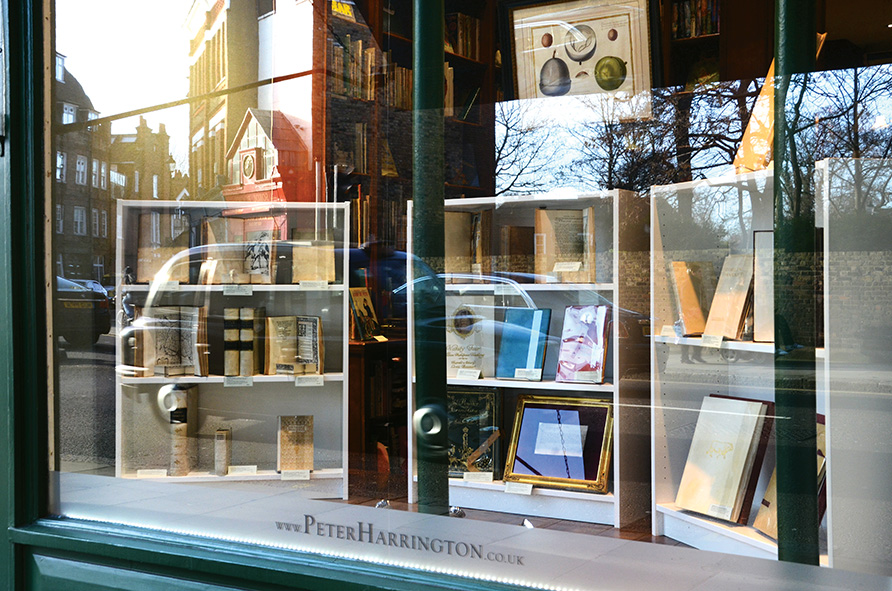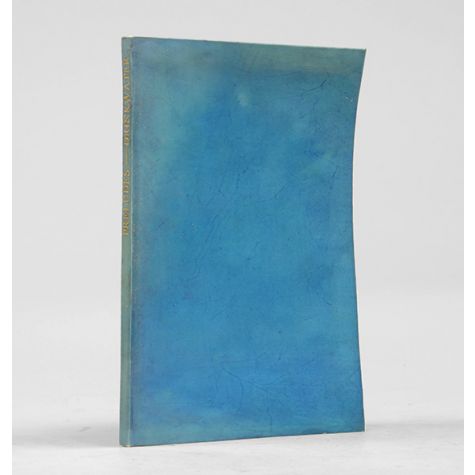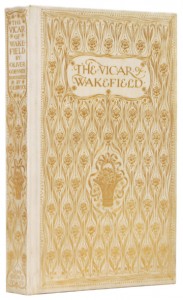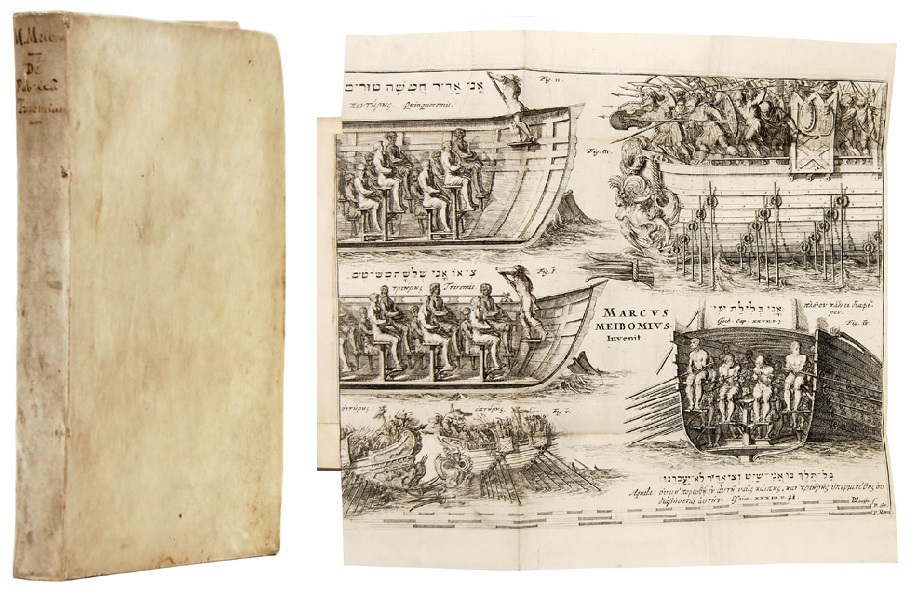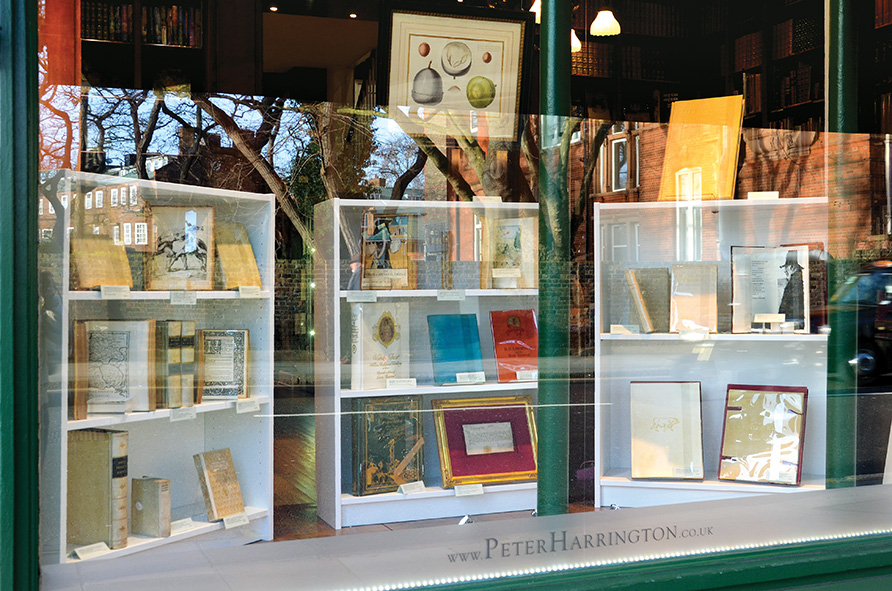
Vellum is derived from the Latin word “vitulinum” meaning “made from calf”, leading to Old French “vélin” (“calfskin”). It is a prepared from the skin of calves, lambs, or kids, not tanned like leather but stretched, scraped and dried under tension, creating a stiff, white or yellowish parchment. Vellum is often encountered in the rare book world; it has long been used as a writing medium, as well as for the binding of books – and the expensive and exquisite process of printing on vellum saw a revival during the private press era.
Below you will find a selection of items printed on or bound in vellum, all on display at Fulham Road. Simply click any of the titles to view it in more detail.
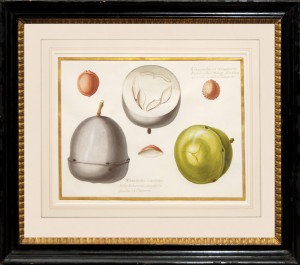
AUBRIET, Claude.
“Ghandirobe vel Nhandirobe”; two studies of fevillea. – SOLD
Paris, c.1740
Bodycolour, watercolour, heightened with white on prepared vellum (448 × 306 mm) bordered on all sides in gold.Captioned; Ghandirobe vel Nhandiroboe/Brasiliensibus Maregr. Hist. Planta. 47. semen in ambitu detatum. and. Nahandrioboe scandentis, foliis Hederaceis, angulosis fructus ex Plumerio. Very good, framed and glazed.
From the same album as a drawing of the same size of the “Mirabilis Dichotoma” plant in the Fitzwilliam Museum in Cambridge (see Scrase, Cambridge 1997, cat. no. 15) as well as similar sheets in the Lindley Library, The Horticultural Society, London (Blunt/Stream, Suffolk 1994, pp.116/117, chapt. 9, ill. in colour pl. 29/30) “In the seventeenth century one of the main centres of flower drawing was Paris, where Nicolas Robert’s works inspired Louis XIV to commission a series of botanical paintings on vellum, known as Les Velins du Roi. Robert painted twenty of these a year for the King, a tradition maintained by his successors including Claude Aubriet… “.(Scrase, p.2) “… (Aubriet) moved to Paris where he worked with Jean Joubert (active c. 1688 – 1706) in the production of the Velins du Roi …. In 1701/2 Aubriet accompanied Tournefort as a draughtsman on a journey to the Aegean and the Black Sea, resulting in the introduction of a number of new plants to Western Europe. … In 1706 he succeeded Jean Joubert as the official painter at the Jardin du Roi, a post he held until his death. …” (Scrase, p. 36).”These illustrations, made no doubt under Tournefort’s direct supervision, are remarkable for the accuracy of their dissections” (Blunt/Stearn, p. 116).
£6,000
BARBUSSE, Henri.
L’Enfer. – SOLD
Paris: Albin Michel,
Octavo (184 x 125 mm). Contemporary full vellum, calligraphic titles to spine in black and gilt, border to boards in black and gilt, top edge gilt, others untrimmed, marbled endpapers. Small ownership signature to first binder’s blank, a couple of faint creases to prelims. An excellent copy.
First complete edition, limited to 100 copies printed on Dutch paper, of which this is number 57 (another 50 copies were printed on japon paper). From the library of E. L. Spears, with his armorial bookplate to the front pastedown. With the original wrappers bound-in.
£275
(BASKIN, Leonard) HUGHES, Ted.
Moortown Elegies. – SOLD
London, Rainbow Press, 1978
Octavo. Original vellum boards, illustration to upper board and titles to spine gilt. With the cloth slipcase. Illustrated by Leonard Baskin. Fine in fine slipcase.
First Edition, First Impression. Limited to 175 copies signed by Ted Hughes.
£600
(BAUMER, Lewis) THACKERAY, William Makepeace.
Vanity Fair. BOOK SOLD
London: Hodder and Stoughton,
Quarto. Finely bound by The Chelsea Bindery in vellum, title block to spine gilt, original miniature portrait with gilt decorative frame to front board, title block to front board, cream endpapers, gilt edges. With 20 tipped in colour plates, captioned tissues. A couple of leaves lightly foxed, little bit of rubbing to the miniature portrait on front board, an excellent copy.
Signed limited edition of 350 copies. A fine example of the Chelsea Bindery’s work.
£1,500
(BROCK, C. E.) GOLDSMITH, Oliver.
The Vicar of Wakefield.With twenty-five coloured illustrations by C. E. Brock.
London: : J. M. Dent & Co; New York, E. P. Dutton & Co., 1904
Octavo. Original vellum, titles and elaborate decoration to spine and front board, top edge gilt, others untrimmed. Colour frontispiece, vignette title, and 23 plates by C. E. Brock. Gift inscription to verso of binder’s front blank, endpapers browned and some minor spotting to a few leaves, an excellent copy.
First Brock edition in the deluxe binding.
£200
BUNYAN, John.
The Pilgrim’s Progress. BOOK SOLD
London: Essex House Press, 1899
Octavo. Original stiff vellum, titles to spine in black, yapp edges. Engraved frontispiece. Text printed in red and black. Vellum a little rubbed and dulled. An excellent copy.
First edition thus, one of a limited edition of 750 numbered copies. One of the earliest productions of the Essex House Press, which was established by C. R. Ashbee, a follower of William Morris, in 1888 as an integral part of Ashbee’s Guild of Handicraft.
£675
BUTLER, Samuel.
Hudibras,In Three Parts, Written in the time of the Late Wars… with large annotations and a preface by Zachary Grey, LL.D. In two volumes. BOOK SOLD
London, by T. Bensley, for Verner and Hood & 8 others in London, 1799
2 volumes, large octavo (230 × 143 mm). Contemporary full vellum, covers panelled in blue, double blue lettering-pieces attractively gilt, marbled endpapers, blue sprinkled edges. Engraved portrait frontispiece, 17 engraved plates by Ridley after Hogarth, woodcut headpieces by Charles Nesbitt, woodcut title vignettes. Lightly rubbed, a little offsetting from plates, an excellent set.
First edition with Nesbitt’s woodcuts of Hudibras, the celebrated mock-epic satirizing the English republicans, with Zachary Grey’s notes, which kept Butler’s world of outmoded learning accessible to later generations, printed on royal paper. Charles Nesbitt (1775-1838) was a pupil of Thomas Bewick’s (indeed, “The best wood engraver that has proceeded from the work shop of Thomas Bewick”, according to W. Chatto, A Treatise on Wood Engraving) and the woodcuts here are in Bewick’s style, so much so that they are sometimes attributed to him, despite their being clearly signed “C. Nesbitt”. Bewick did, however, own a copy of the book – see A Provisional Checklist of The Library of Thomas Bewick, drawn up for The Bewick Society by David Gardner-Medwin.
£650
(CHELSEA.)
The Chelsea Historical Pageant,Old Ranelagh Gardens, Royal Hospital, June 25th – July 1st, 1908. Book of Words. With Illustrations and Selections from the Music. – SOLD
London: Printed for the Pageant Committee, 1908
Large square octavo (249 x 190 mm). Specially bound for presentation in contemporary quarter vellum, spine gilt tooled with art nouveau rose motifs and red morocco onlays, red morocco label, pink cloth sides, gilt arms of the Metropolitan Borough of Chelsea on front cover, top edges gilt, untrimmed, marbled endpapers. With the original pictorial wrappers bound-in. Monochrome frontispiece, 23 plates (12 in colour), double-page map. Spine a little dulled, vellum and sides lightly mottled, a little sunned at periphery of covers. An attractive copy.
First and only edition. A remarkable association copy: from the library of one of the “Makers of the Pageant”, G. Ambrose Lee (also a member of the book’s editorial sub-committee); with his red ownership Japanese “chop” at head of title, his official pass pasted to the front free endpaper, and with a presentation label signed by the president, vice-presidents, honorary secretary, and honorary treasurer. Additional material relating to the Pageant include: three original photographs pasted-in (one signed by Kate Pragnell, the others most certainly also by her), the official programme, and a plan showing “Approaches to the Pageant”. George Ambrose de Lisle Lee (1862-1927) was York Herald of Arms in Ordinary from 1905 until 1922 and a connoisseur of Japanese art. A fever for pageants of all kinds swept Britain in the early years of the 20th century and the Chelsea Pageant of 1908 celebrated the history of the borough in ten episodes of dramatic performances, music and dancing.
£250
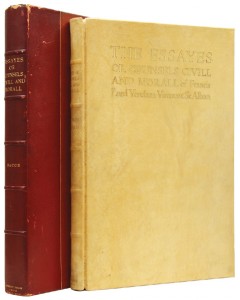
(CRESSET PRESS.) BACON, Francis.
The Essayes or Counsels Civil and Morall. – Sold
London: The Cresset Press, 1928
Folio. Original full vellum, titles to spine and upper board gilt, top edge gilt, others untrimmed. Printed in red and black. Housed in a red cloth slipcase and chemise. A few tiny spots to boards. An excellent copy.
First edition thus, one of 250 copies on Batchelor paper out of a limited edition of 258 numbered copies.
£750
(DE HOOGHE, Romeyn, illus.) PETTER, Nicolaes.
Klare Onderrichtinge der voortreffelijcke Worstel-konst,Verhandelende hoeman in alle voorvallen van Twist in Handtgemeenschap, sich kan hoeden: en alle Aengrepen, Borst-stooten, Vuyst-slagen &c. verstetten.
Amsterdam: Johannes Jansonius van Waesberge, 1674
Quarto (235 × 189 mm). Contemporary full vellum, remnant of ink lettering to the spine. 71 etched plates by Romeyn de Hooghe, plate 6 was originally duplicated and the duplication corrected at the time by the imposition of the correct plate numbered 7, over it, so neatly is this done that it is barely visible from the recto. A little rubbed, the front free endpaper somewhat creased and with some loss at the lower corner, light browning, a few faint damp-stains in margins, occasional finger-soiling, some minor chipping at the edges, but overall very good.
First edition of this renowned manual of self-defence. The work is particularly notable for the telling combination of de Hooghe’s clear, but nonetheless dramatic, illustrations, and the simplicity and lucidity of Petter’s written instructions. Prof. Sydney Anglo describes it as “historically speaking, the most important treatise on unarmed combat ever printed … the finest of all wrestling books and deservedly the most famous” (The Martial Arts of Renaissance Europe, p.190). While Eli Steenput, in the introduction to his English translation (Journal of Western Martial Art, October 2000), remarks that “It is probably unique in presenting an effective and complete unarmed combat system in a format from which it would be actually possible to learn”. In themselves de Hooghe’s plates are remarkable, fully justifying Otto Benesch’s description of him as “not only the greatest Dutch etcher of the period, but the only great artist Holland produced at the end of her classical era … one of the greatest illustrators of all time, comprehending within himself all the various faculties of the universal mind of the Baroque”.
Wrestling-master Petter’s school of practical self-defence for the bourgeoisie on the dangerous streets of Amsterdam, clearly differentiates the book from the earlier tradition of wrestling books, such as the Ringbüchlein, or Fabian von Auerswald’s Ringer-Kunst, where smiling contestants are shown engaged in a sporting contest. Iinstead the plates portray well-dressed gentlemen tangling with grimacing, sometimes armed, street toughs. Petter died shortly before publication, and the book was seen through the press by his widow, and his pupil Robert Cors, who explains the principles that lay behind his master’s method; “The forces which were lent to the human understanding by nature, are not present alike in each art, and if they were, then they would nevertheless not be developed in the same way. Of two arts one is usually superior, this is in general the one based on knowledge. Most people do not seriously consider how they could secure themselves against all manner ofd abuse or assault, as might be levelled against them by evil-hearted villains, eager for violence. Our wrestler has studied this problem, first developing his mind, then looking for effective strikes and holds, by which one can defend against violent attacks with shoves, punches, or a knife. These he has practised diligently, and, to benefit the community, he has decided finally to compile this instructional book … Cruel Death has untimely taken him from us, before he could bring this project to conclusion. The images had already been prepared during his life, ordered and provided with explanatory captions to instruct the studious wrestler”. By way of advertisement, Cors mentions that he is “prepared to instruct interested parties in these techniques for reasonable remuneration and be reached at the Witwe house of Nicolaes Petter on the Prinsengracht in the Gustavusburgh not far from the combat academy”.
Far from common institutionally, just 20 or so copies world-wide, with most of them in the Netherlands, and very rarely encountered commercially, particularly so in such wonderful, unrestored contemporary condition. This copy with an early anonymous bookplate and the later plate of Amsterdam doctor and bibliophile, Bob Luza, whose collection was sold in 1981.
£8,500
DRINKWATER, John.
Preludes 1921–1922.
London: The Morland Press, 1922
Square octavo. Original pale blue limp vellum, top edges gilt, fore-edges untrimmed. Title-page printed in blue and black, initial letters printed in blue. Patchy light fading of vellum, which has also sprung a little. An excellent copy.
First and signed limited edition, preceding the trade edition of the same year. Number 1 of 125 numbered copies, neatly initialled by the author with his monogram. An attractively produced book.
£275
(DULAC, Edmund.) STEVENSON, Robert Louis.
Treasure Island. – SOLD
London: Ernest Benn Limited, 1927
Quarto. Original full vellum, black morocco label, top edge gilt. Housed in a recent tan cloth chemise and quarter morocco slipcase. Colour frontispiece, 11 other plates and black and white illustrations in the text by Edmund Dulac. Library bookplate, perforated library stamps to some pages (including title page), endpapers a little dust-soiled and with a couple of small creases. An excellent copy.
Signed limited edition. Number 9 of 50 copies on handmade paper signed by the illustrator. In her bibliography of the artist Ann Conolly Hughey described the illustrations of Treasure Island as his “most careful and superb”. Dulac himself considered Treasure Island as his best work.
£3,750
FOSTER, J. J.
British Miniature Painters and Their Works.
London: Sampson Low, Marston & Company, Limited, 1898
Quarto (290 × 208 mm). Contemporary vellum, black morocco label, decoration to spine, single rule to boards, cream endpapers, gilt edges. With 60 monochrome illustrations. Inscription to front free endpaper, some occasional light foxing, spine and boards marked, a very good copy.
Limited to 425 numbered copies. A handsomely bound copy.
£225
GUNN, Thom.
Mandrakes. Illustrated by Leonard Baskin.
The Rainbow Press, 1973
Quarto. Original vellum-backed dark brown-red boards. Housed in a red cloth slipcase. Frontispiece and 4 full-page illustrations by Leonard Baskin. A fine copy.
Signed limited edition, one of 150 copies signed by Gunn.
£475
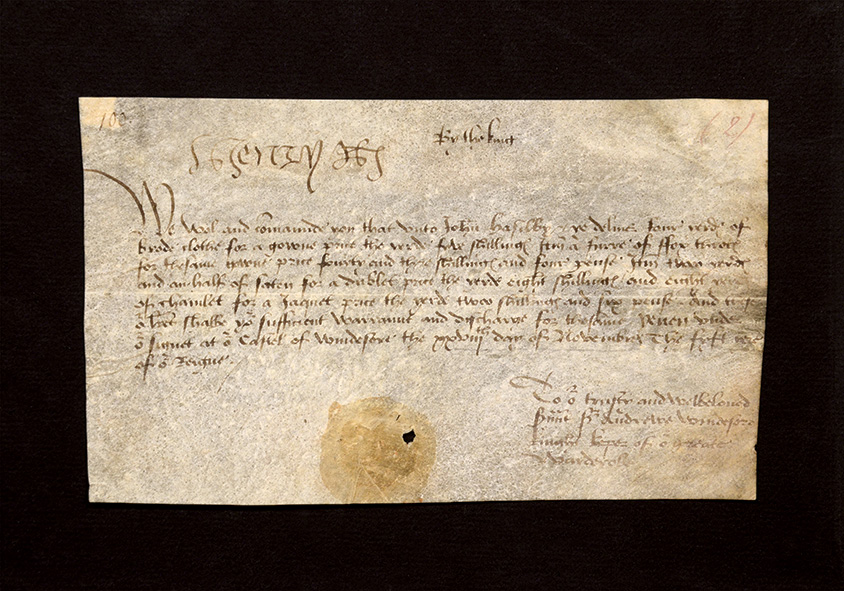
HENRY VIII.
Warrant signed (“Henry R” at head), to Sir Andrew Windsor, Keeper of the Great Wardrobe, requiring him to deliver to John Hasilby four yards of broad cloth for a gown at 5s. the yard, plus a fox fur for the same gown at 43s. 4d., three-and-a-half yards of satin for a doublet at 8s. the yard, and eight yards of chamlet (a type of fine cloth) for a jacket at 2s. 6d. the yard. – SOLD
Windsor Castle: 28 November,
Warrant on vellum (108 x 178 mm), later docket numbers “100” (top left) and “2” (top right), round mark and small hole in vellum where seal was formerly affixed, borders trimmed.
A royal warrant ordering a significant amount of cloth to be given to a servant of Queen Katherine, John Hasilby. The matter of clothing was of high public importance in the Tudor court. “Henry VIII passed four sumptuary laws or acts of apparel in 1510, 1514, 1515, and 1533. The laws were hierarchical in their structure, with social status being directly linked to the quality of cloth that an individual was allowed to wear. Expensive, imported silks, furs, and metal thread acted as material signifiers of status and the individuals permitted to wear them were clearly identified as the elite” (Maria Hayward, Rich Apparel: Clothing and the Law in Henry VIII’s England, 2009, p. 17). The keeper of the great wardrobe was one of the key dispensers of patronage sanctioned by the king.
These early years of their marriage saw Katherine’s hold on her husband and her political influence at their height. Until 21 October 1513 she had been governor of the realm and captain-general during Henry’s absence campaigning in France. She faced a crisis when James IV of Scotland invaded England on 22 August.
As in the later Field of Cloth of Gold of 1520, the political symbolism of her role was expressed through the medium of fabric. Katherine described herself during the invasion scare as “horribly busy with making standards, banners and badges” (her mother Isabella of Castile also took it upon herself to supervise the making of banners on campaign), and when the defeat of the Scots at Flodden on 9 September left James IV and a large number of Scottish nobles dead on the field, Katherine wrote triumphantly to Henry, in her own hand and in English: “In this your grace shall see how I can keep my promys, sending you for your banners a King’s coat.”
The king’s gift to the queen’s servant of these sumptuous fabrics was an ostentatious acknowledgement of his gratitude for her successful campaign and her continuing authority at court.
£30,000
JOYCE, James.
Ulysses. BOOK SOLD
London: John Lane, The Bodley Head, 1936
Quarto. Original white vellum, titles to spine and the Gill-designed Homeric bow device to boards, top edge gilt, others uncut. With the publisher’s slipcase. Spine very slightly faded but a particularly nice copy in the somewhat rubbed and marked slip case.
First UK edition, first impression. From a total printing of 1,000 numbered copies, this is one of 100 on handmade paper, bound in vellum and signed by the author. This deluxe issue of the Bodley Head Ulysses is one of the triumphs of 20th century book production. It established the text for the succeeding 25 years and printed as appendices the International Letter of Protest against Samuel Roth’s piracy and the famous legal judgement by John M. Woolsey lifting the ban in America on the publishing of the book.
£30,000
(KELMSCOTT PRESS.) SHAKESPEARE, William.
The Poems of William Shakespeare,Printed After the Original Copies of Venus and Adonis, 1593. The Rape of Lucrece, 1594. Sonnets, 1609. The Lover’s Complaint.
Hammersmith: The Kelmscott Press, 1893
Octavo. Original limp vellum by Leighton of London, titles to spine gilt, blue silk ties. Printed in black and red. Spine a little dust-soiled, ties torn away at ends, a very good copy.
First Kelmscott edition, one of only 500 copies printed.
£3,250
(LAWRENCE, D. H.) CARTER, Frederick.
D. H. Lawrence and the Body Mystical. BOOK SOLD
London: Denis Archer, 1932
Large octavo. Original orange vellum, titles and decoration to spine and upper board in black and gold. With the original celluloid dust jacket. Portrait frontispiece. Contents lightly toned. An excellent copy in the mylar jacket.
First edition, first impression. One of a limited edition of 75 numbered copies each containing a signed artist’s proof of the engraved portrait.
£250
MEIBOM, Marcus.
De Fabrica triremium liber.
Amsterdam: 1671
Quarto (201 × 142 mm). Contemporary vellum, title inked to the spine, marbled edges. Superb folding etched frontispiece by Romeyn de Hooghe showing 5 separate sections of oared vessels, printer’s device to title page, diagrams to the text, extensive use of Hebrew and Greek types. Eighteenth-century ownership inscription of the classical scholar Johann Christoph Wernsdorf to the first blank. Covers just a little rubbed and mildly sprung, first blank separating, but not loose, light toning, a highly attractive copy.
First and only edition of this uncommon treatise on ancient shipbuilding, drawn from classical and Biblical sources, illustrated with a beautiful, etched frontispiece by de Hooghe. Born in Tönningen, Schleswig-Holstein, around 1630, Meibom was a Danish philologist and polymath scholar probably best known for his work on music in antiquity. His Antiquae musicae auctores septem of 1652 printed seven Greek works together with his Latin translations of them, and it is known that he attempted concerts of reconstructed Greek music. Meibom was summoned to the court of Queen Christina; became a professor at the Soroë Academy at the time when Christian IV was attempting to turn it from a “knight academy” into a full university; was later chief of the customs office as Helsingöer; and was made professor of history at the Athenaeum in Amsterdam in 1668. In the present work he essays an accurate reconstruction of the construction and organization of the ancient trireme from a collation and analysis of contemporary sources. Dedicating the book to the kings, princes and Christian republics of the shores of the Mediterranean, he explains that triremes were the principal warships of the ancient world and assures his readers that he has “tried, by means of this book to re-launch them into the sea, not from ship-sheds where they, having been pulled on the shore, have stood until the present time, but brought forth from the much-venerated ancient monuments of letters.” An important early-modern work of marine archaeology.
£8,500
MOSCHOPULOS, Manuel.
De ratione examinandae orationis libellus. Ex bibliotheca regia.
Paris: Robert Estienne, 31 Dec. 1545
Quarto (245 × 164 mm). Nineteenth-century blind-stamped vellum over pasteboards, spine neatly lettered in manuscript, old shelf-mark at foot. Greek type; Estienne’s basilisk device as king’s printer in Greek on title-page; foliated and grotesque Greek initials and matching headpieces. Ownership inscription of Sir John Taylor Coleridge (1790-1876; nephew of the poet), dated 1853, noting the previous owner as Dr Butler, Dean of Peterborough, on the front free endpaper. Spine a little dusty, faint stain to upper outer corner through to p.24, not affecting text, else an excellent copy, fresh and clean.
Editio princeps. The Byzantine scholar Manuel Moschopulus (fl. Constantinople 1282-1328) had been a student of Maximus Planudes; this grammar formed the basis of the later works by Chrysoloras, Theodore Gaza, and Constantine Lascaris. The book, the only quarto among Estienne’s superb sequence of editiones principes, is only the second text (after Estienne’s edition of Eusebius the previous year) to be printed entirely in the French royal Greek types (grecs du roi) cut by Claude Garamond, widely regarded as the finest Greek types ever cut.
£3,500
(NIELSEN, Kay) QUILLER-COUCH, Arthur.
In Powder and Crinoline.Old Fairy Tales Retold. BOOK SOLD
London, Hodder and Stoughton,
Quarto. Original full green vellum, front cover and spine lettered and pictorially stamped in gilt, pictorial endpapers, top edge gilt, others uncut. With 26 tipped-in colour plates on grey paper. Covers very slightly bowed, minimal wear to extremities. An excellent copy of this title, with the endpapers very slightly foxed as usual.
Edition de Luxe, limited to 500 numbered copies signed by the artist.
£3,750
PLATH, Sylvia.
Crystal Gazer and Other Poems – BOOK SOLD
London: Rainbow Press, 1971
Tall quarto. Original limp vellum, titles to upper cover gilt, burgundy silk ties, top edge gilt, others untrimmed. Housed in the publisher’s red cloth solander case. A fine copy.
First edition, first impression. One of 20 copies bound in full vellum from a limited edition of 400 numbered copies. Twenty-three poems collected here for the first time, many of which were previously unpublished.
£1,750
(RACKHAM, Arthur.) ROSSETTI, Christina.
Goblin Market.
London: George G. Harrap & Co. Ltd, 1933
Octavo. Original limp vellum, title to front cover in gilt, top edge gilt, others untrimmed, pictorial endpapers. Housed in publisher’s original slipcase. Colour frontispiece, 3 similar plates, and black and white illustrations throughout. Light cockling to leaves. Otherwise a fine copy in a slightly soiled slipcase with minor wear to extremities.
Signed limited edition, number 183 of 410 copies signed by the illustrator.
£1,000
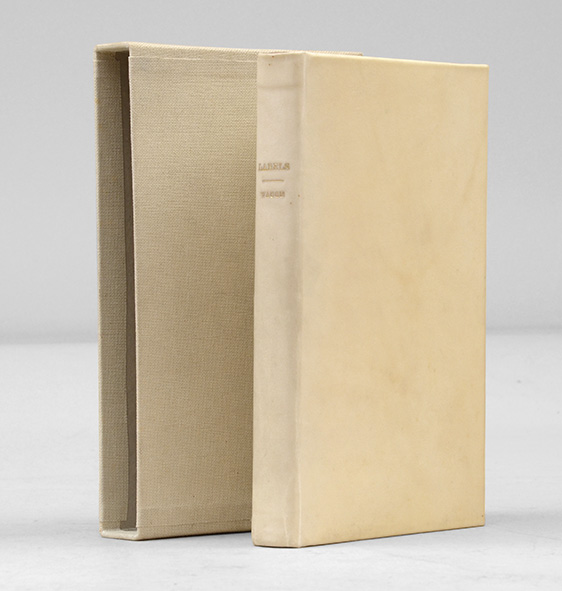
WAUGH, Evelyn.
Labels. A Mediterranean Journal. – SOLD
London: Duckworth, 1930
Octavo (214 × 219 mm). Contemporary full vellum, titles to spine gilt. Housed in a white cloth slipcase. Spine a little faded, minor spotting to edges of text block and to contents. An excellent copy.
First edition, first impression. Handsomely rebound in full vellum.
£250
